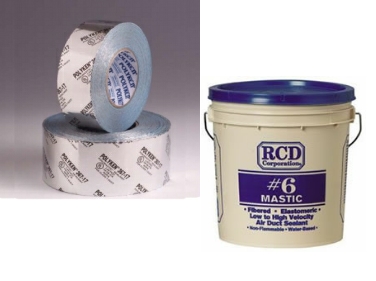
As the high temperatures across the country start to set records, what steps have you taken to reduce the amount of money being spent to cool your home?
For many, the answer is insulating the attic, basement, and garage. While insulating these areas will definitely help you cut costs, there is another area that can easily be forgotten: ducts.
According to Energy Star, ducts that are leaking air can easily release up to 20 percent of conditioned air flowing through them. This leads to energy loss, a less efficient cooling system, and higher energy costs. Not only that, leaks allow dirt and moisture to infiltrate your ductwork, encouraging mold growth that can make you sick.
Don’t automatically reach for the duct tape to solve this problem, however. It’s a short-term fix. The adhesive on duct tape dries out over time, allowing leaks to re-form. Applying duct mastic, whether tape or putty, for sealing ducts helps take care of all of these problems at the same time.
Mastic Tapes
A simple way to go about sealing ducts is through the use of mastic tape. The tape can be applied to flexible duct, fiberglass duct board, and metal ducts, including stainless, galvanized, and aluminum. It can be used indoors or outdoors, as it is weatherproof and able to withstand temperatures as high as 200 degrees Fahrenheit to as low as 20 degrees Fahrenheit.
Duct Mastic Bucket
Another tool that is used for sealing ducts is the duct mastic, a fibrous adhesive sealant that has the consistency of putty, allowing it to be malleable. It can be used on ducts that lack insulation as well as for coating of thermal insulation on ducts and pipes. Like the mastic tapes, this sealant has the ability to withstand extreme temperatures.
The duct mastic is non-flammable, non-toxic, and dries completely within 30 minutes of application. Mastic comes in a bucket for application with a putty knife or trowel, or in a tube for use with a caulking gun. The best kind of mastic is water-based. It performs at least as well as other types, is easier to use and clean up after, and won’t expose you to dangerous VOC’s.
The most likely places to find leaks in your ductwork is where two components meet. Inspect all connections and seams in your ductwork and coat any suspicious areas with mastic. About a ¼ inch bead (if you are using the tube) should be sufficient. A tube of mastic will cover about 50 linear feet; if you have to do a large amount of air sealing to do it might be more cost-effective to get your mastic in a resealable bucket.
Once ducts have been sealed, the problem of losing conditioned air through this source will be eliminated. Limiting the amount of pressure put on the cooling system in this way helps increase its efficiency and possibly its shelf life. The reduction in energy loss added to the increased efficiency of the cooling system leads to less money being spent during the summer months to cool the home. When less money is necessary to cool the home, you have more money to budget however you would like.
Mastic is an inexpensive and very effective solution to a problem many people don’t even know they have. But once you see the difference in your energy bills, you’ll wonder why you didn’t do it sooner!

There are many ducts out there like insulated flexible duct , industrial flexible ducts , semi rigid flex duct. Which one i can use in summer please tell me.